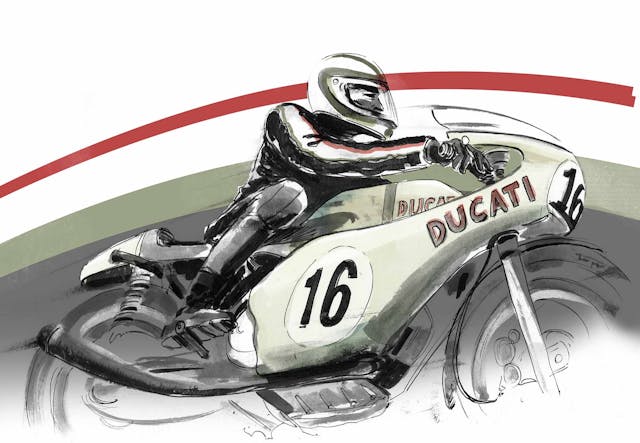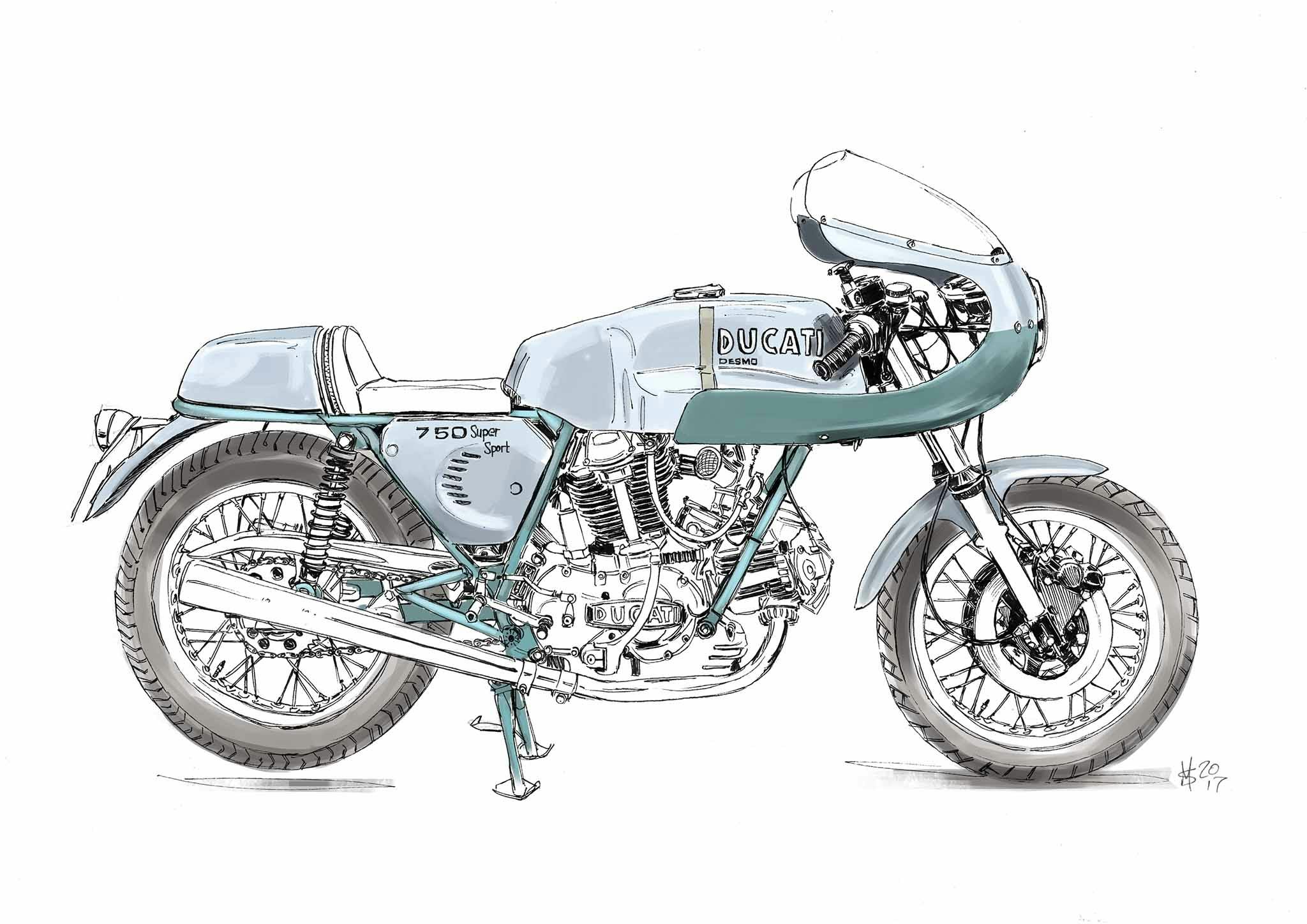Media | Articles
Stock Stories: 1974 Ducati 750 SS
With custom bike culture exploding in recent years, the history and importance of the two-wheeled machines that first rolled off of the production line are often overlooked. Stock Stories tells the tales of these motorcycles.
One of Italy’s most memorable vintage superbikes is the 1974 Ducati 750 SS. The motorcycle’s smooth power delivery and small production run are essential to its appeal, but the fact that the bike is an incredibly faithful and street-legal replica of the 1972 Imola 200-winning machine makes it a hallmark of Ducati racing heritage.
The 1972 Imola 200
Englishman Paul Smart reluctantly agreed to ride for Ducati after being persuaded by his wife, the sister of motorcycle racer Barry Sheene. The 1972 Imola program even listed Sheene as set to ride a Ducati, but Triumph/BSA ultimately offered him a better deal. The British team went bust in the interim, leaving Sheene without a ride and opening a slot for Smart.
Ducati had big dreams for its highly-developed engine. Still, Smart admits that he was initially unimpressed with the Ducati 750 when he turned up to Modena for practice. Having just come from a race in Atlanta where he had ridden “one of the most evil handling motorcycles in the world,”. this four-stroke twin seemed like a rather nostalgic machine. He was worn from travel and feeling a bit pessimistic, and after 10 laps of practice Smart didn’t have much to say. The crew made minor adjustments before he was out for another 10 laps, and to Smart’s surprise, he pulled into the pits after practice to find that he had broken Giacomo Agostini’s lap record.
Despite this, Agostini was on pole for MV Agusta and the field at Imola was full of top riders on competitive machines. The Ducatis, however, were already causing regretful rumblings in the pits from those who had refused a test ride. Team manager Fredmano Spairani was so convinced that Ducati was going to dominate on home turf, he told Smart and his teammate Bruno Spaggiari that if they split the first- and second-place prize money they could keep the winning bikes for themselves.

The circuit that runs around the hills behind the old Italian town of Imola was at the time an old-school Grand Prix affair. These were public roads, but the circuit was designed for racers to hit high speeds during the 200-mile race. Smart and Spaggiari were reaching 150+ mph in the heat of competition and managed to stay out in front, fulfilling Spairani’s prophecy by placing first and second, respectively.
Marketplace
Buy and sell classics with confidence
Smart did get to keep the 750 (also known as the 750 Imola Desmo) on the condition that he campaign it in international races in the U.K. Keeping his word, he went on to win the Hutchinson 100 at Brands Hatch, beating the current champion Phil Reed.
The 750 Imola Desmo racing bikes that won the 1972 Imola 200 were developed in the workshop next to test driver Franco Farnè’s office, where mechanic Giuliano Petritti worked with Farnè to develop Ducati’s motorsports machines. The Imola racers were made using ten GT frames, similar, to the one used by the 750 Sport roadster that Ducati released in 1972.
1974 Ducati 750 SS

Ducati aficionados would have to wait two years until the factory released its first real race replica: the production 750 SS. Only 401 of the original “round case” versions were built—Ducati’s only round case to use desmodromic valve gear.
Fabio Taglioni, chief designer and technical director at Ducati, had been using desmodromic valve systems in the brand’s racers since the late 1950s. The system wasn’t new at the time, and it appeared in patents as far back as 1896. Various parties had experimented with the technology over the years, including Mercedes-Benz which used it in its 1954–55 Formula 1 cars. The first Ducati “Desmo” was the 1957 125 Grand Prix Desmo.
Valve springs had become a limiting factor in engines running at higher revolutions, as they would cause valve float that would render the engine unable to generate enough force to close the valve. Here was Taglioni’s take:
“The specific purpose of the desmodromic system is to force the valves to comply with the timing diagram as consistently as possible. In this way, any lost energy is negligible, the performance curves are more uniform and dependability is better.”
In order to “force the valves to comply,” the desmodromic system uses a springless return mechanism—in the form of rocker arms—to close the valve.
The production 750 SS was very close to the race-winning versions, and not only with regard to the engine; the large fuel tank and round back seat unit were retained, while the fairing was a cockpit version rather than the full fairing as used on the Imola bikes. Design-wise, the cockpit allowed the engine to shine, giving it a more stylish look.
Rarity and racing legacy
These bikes are rare nowadays, and not only because of the limited production volume from the outset. Attrition due to wear and tear is a factor, of course, but they were used hard and often used for racing, due to the smooth power delivery from the desmodromic valvetrain and Delorto PHM40A 40mm carburettors.
One famous example with 1970s competition history is a 750 SS named “Overdog,” campaigned by Phil Schilling (tuner) and Cook Neilson (rider and editor of Cycle Magazine at the time). Overdog was very competitive at club level, and by 1977 the 750 SS was bored to 883cc and renamed “California Hot Rod.” That was quite a mouthful, so it wasn’t long before the Duc was renamed to “Old Blue,” which was easier to say around the workshop and made sense with the change in color to dark blue.
Old Blue, famously, came out on top at the 1977 AMA Superbike race at Daytona. Seeing this victory as a highly valuable publicity opportunity, Ducati encouraged its dealers to sell 750 SS models to racers who could campaign them on track. Ducati went a step further by providing over-the-counter race kits to amp up the bikes’ performance. Stock examples of the 750 SS are extremely rare as a result of this initiative; not only were the engines tuned and blown up, but frames were modified and the fiberglass tanks had a tendency to deteriorate under race stresses.
Though they’re rarely seen at all today, let alone in stock form, the 750 SS is no doubt one of Ducati’s most significant creations, with a track record that left a lasting impression on the motorcycle world.












